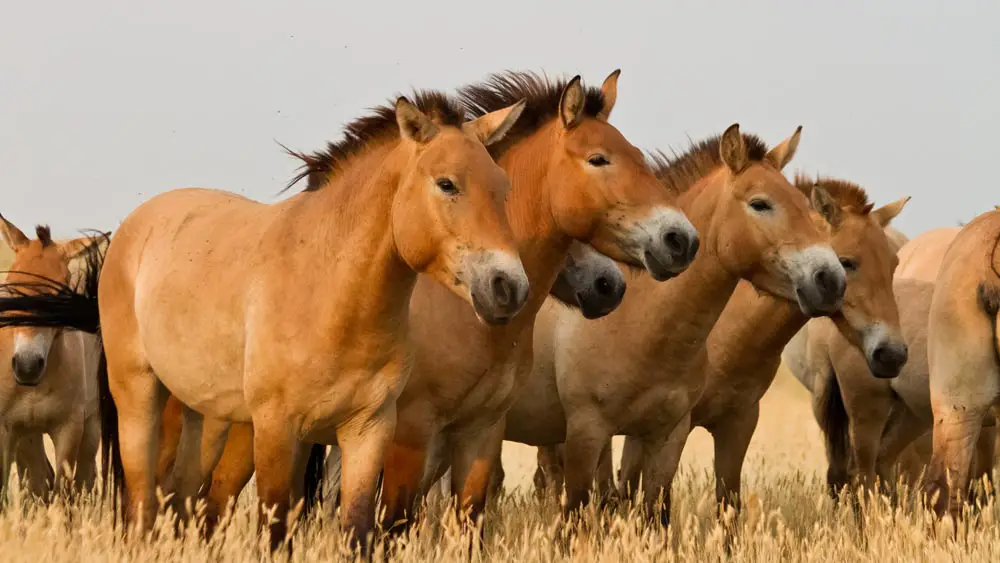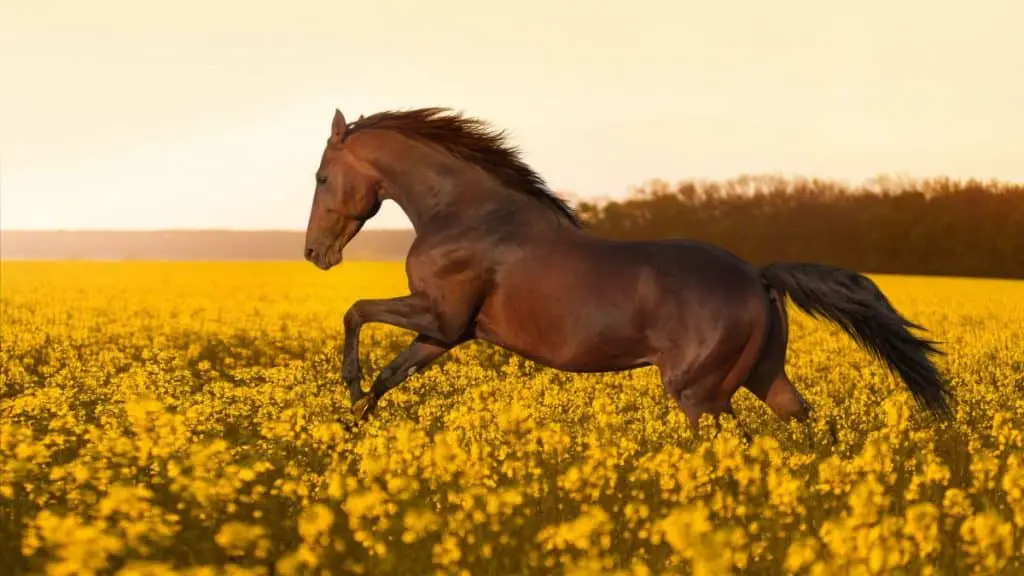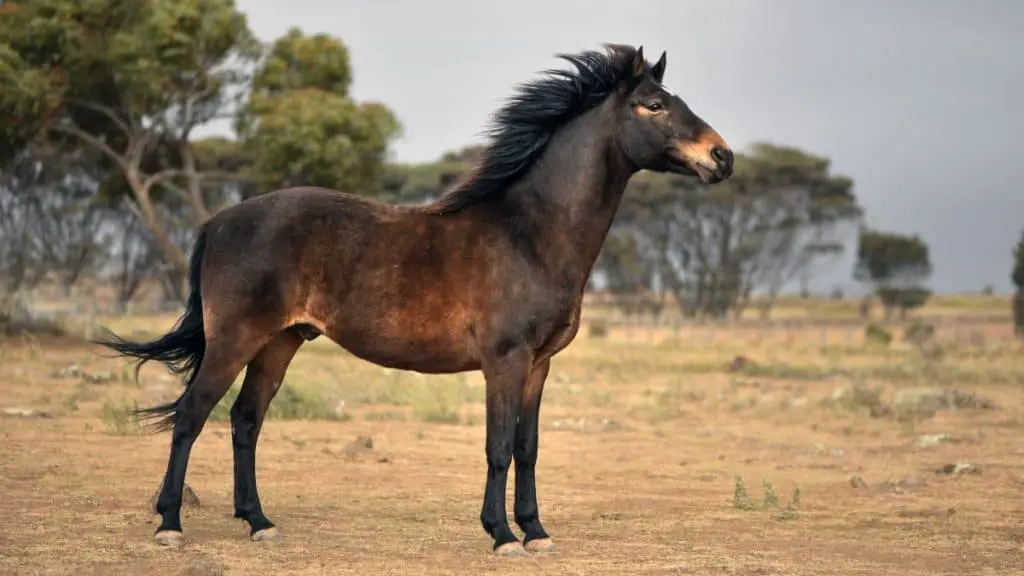Skip To Section
While any horse can be dangerous, certain horses are more likely to exhibit violent or aggressive behavior than others, either due to temperament, training, or instinct. Wild and feral horses can be particularly dangerous, as can hot-blooded breeds of horse such as thoroughbred racing horses.
If you’ve been wondering which horse breed in the world is the most dangerous then this article is for you. We tell you more about aggressive behavior in horses, explain which horses might be aggressive in particular situations, and talk about some of the other dangers associated with horses and horse riding.
There is not just one breed of horse more dangerous than other breeds. All horses have the potential of being as dangerous as each other. Some horse breeds may have more factors of showing aggressive behavior under certain conditions or circumstances which we have covered below.

Factors That Cause Aggressive Behavior In Horses
1. Sex
Stallions are generally more aggressive than mares or geldings and more difficult to handle, especially in the vicinity of any mares in estrus and ready to breed. Aggression in stallions could be compounded by the fact that humans are far more used to dealing with mares and geldings and may not have a good understanding of stallion behavior.
2. Maternal Instinct
Mares with a foal can be aggressive if they feel their offspring are threatened. After birth, aggression by mares is hormonally driven and normal for the first few days, decreasing gradually over time. It is therefore important to familiarize mares before delivery with any caretakers and other humans likely to be around them. After delivery, minimal contact with other people is advisable.
3. Territorial Behavior
Horses can become aggressive towards perceived intruders or competitors, asserting rights to food and water resources in their territory, or even trying to steal away domesticated mares into their herd.
4. Pain Or Discomfort
When a horse is in pain from an injury, illness or physical discomfort (e.g. insect bites, being held in an uncomfortable position) the threshold of their temper may be lowered and they may lash out more easily at irritations around them, including human beings.
5. Hunger, Thirst
Similarly, if hungry or thirsty, a horse might be more prone to aggression out of both lowered temper threshold and determination to get to food or water resources.
6. Breeding
Breeds of horse which are classified as ‘hot blooded’ are generally characterized as being more intelligent, energetic, and spirited, but also highly strung, stubborn, and often bad-tempered.
Hot-blooded horses require thorough training, regular exercise and are best-owned by humans who understand their breed and its requirements. They are unlikely to be good general riding horses, or suitable for children, therapeutic activities, or riding schools.
Thoroughbred racing horses are particularly known for their high energy and bad temper. Arabian horses and Barbs are further examples of hot-blooded horses whose behavior can become challenging if not properly trained, exercised, and cared for.
Yet another hot-blooded horse that can exhibit aggressive behavior is the Akhal-Teke. Originating in the Turkmenistan desert and bred by nomadic desert people, Akhal-Tekes, or Akhal Tekes, are commonly intelligent, athletic, and incredibly loyal. This intense loyalty, often bonding with only one rider, can be a source of aggression. Akhal-Tekes may protect their rider like a guard dog and lash out at anyone who is perceived to be a threat.
7. Poor Training
Horses may pick up aggressive habits like biting inadvertently through poor training. For example, if a horse is offered food directly from a human being, it might then learn to search for that food on someone’s body, biting at pockets or arms while trying to get at it.
8. Combat Training
There is no such breed as a “warhorse” but there are definitely horses who have been bred and/or trained for aggression and warfare abilities throughout history. As well as carrying soldiers and armaments, some horses were brought to battlefields to kill or injure enemy soldiers and enemy horses.
9. Fear
A frightened horse is a dangerous horse. If a horse perceives a threat, it could lash out with hooves, teeth, or a head swipe. Given their size, even unintentional blows from a horse can be extremely serious or even fatal to humans.
Wild Territorial Horse Breeds
1. Przewalski’s Horse

Named for the Russian explorer N. M. Przewalski, Przewalski’s horse is the last remaining truly wild horse in the world. Other “wild” horses (e.g. mustangs in the USA) have descended from escaped domesticated horses who have adapted to life away from direct human influences. Like zebras and African wild asses, Przewalski’s horses were never successfully domesticated.
Once common across the steppes of East and Central Asia in ancient times, these short, stocky horses are now only found in small re-introduced populations in China, Mongolia and Kazakhstan. Przewalski’s horse has 66 chromosomes in comparison to the 64 possessed by the domestic horse, with the two thought to be descended from a common ancestor (like humans and chimpanzees) rather than the two species being directly related.
As wild horses, Przewalski’s horse are not used to humans and may react with aggression if approached.
2. Mustangs

Mustangs are free-roaming, feral horses found in the Western United States. They are descended from horses originally brought to the Americas by Spanish colonial settlers centuries ago, with populations now also featuring DNA from various other breeds including American Quarter horses, Friesians, and Curly horses.
The mustang population is protected and managed by the USA Bureau of Land Management (BLM) and over-population is a growing concern. If mustangs are captured, domesticated, and trained, they can become good working or riding horses. But if approached in the wild, they could be aggressive and cause serious injury to any human interlopers.
3. Brumbies

Brumbies are free-roaming, feral horses of Australia, with large numbers found in Northern Territory or Queensland. They are descended from a range of escaped or lost domestic horses, some of which would have been owned by the earliest European settlers.
There are thought to be 400,000+ brumbies currently roaming free in Australia, leading to them being regarded as pests in areas where they live close to human settlements and may trespass in gardens, eat crops etc… Like mustangs, captured brumbies can be domesticated and trained for a variety of work, sport, or leisure activities but these horses can still be dangerous in the wild.
There do appear to be fewer aggressive encounters between humans and brumbies than humans and mustangs, perhaps because of more frequent contact.
FAQs
Are Horses Dangerous To Humans?
Some horses can be dangerous to some humans at some times. Thoroughbred stallions are not suitable horses for teaching a child to ride, for example, and approaching a herd of wild mustangs would be extremely reckless.
You should choose a horse suited to your needs by breed, training, and individual temperament, especially when first learning to ride. Friesian horses, American Quarter horses, and Gypsy horses are all examples of breeds that tend to have a steady, calm, and friendly temperament.
Can A Horse Be Dangerous?
Yes, a horse can be dangerous to a human being. To avoid problems, it can be helpful to learn a little about horse body language and behaviors.
Ears: When a horse’s ears are stiffly pointed and its nostrils are flaring, it is probably afraid and there could be a greater risk of it lashing out. If both ears are pointed far back, this can be a sign of anger, again necessitating greater care in approaching the horse.
Biting: If a horse bares its teeth and bites the air, this is a sign that it could bite a human or another horse. Take care and try to work out the reason for this behavior.
Eyes: Horses will focus their eyes on something that is bothering or irritating them. If a horse is staring at you and moves to keep you in its sights, then you may well be angering or frightening the horse and should reconsider your approach.
Body Angling: When a horse angles its backside towards someone or something, that’s a warning that you might expect a kick in that direction.
Tail: Whipping its tail back and forth can be a sign of agitation in horses. Again, this might be the early signal for a kick and a good indication that you should back off and reconsider how to approach that horse.
What Makes A Horse Dangerous?
Any horse can be dangerous for humans who don’t understand horses or don’t understand a particular breed. When first learning to ride or care for horses, it’s important to spend time observing horse behavior and body language and learning to read the signs that could tell you when something is wrong.
Breed, size individual temperament, health, and mood can all play a role in how dangerous a horse can be. Even good-natured horses might pose accidental dangers. For example, it’s a long way down for anyone who falls from the back of a gentle-giant Shire horse. Very nervous horses might be more prone to rearing up with fright and throwing their rider.
Are Horse Bites Dangerous?
Yes. Just because horses are herbivores doesn’t mean that they won’t bite or that their bite won’t be severe. Horses have powerful jaws and big teeth which together can deliver serious injury.
Horses should be trained not to bite.
What Is The Most Dangerous Type Of Horse Riding?
The most dangerous type of horse riding is horse jump racing. This involves horses carrying their riders at high speed around a course of obstacles which could be natural, artificial, or both. The risks are high for both horses and competitors, with certain races always regularly causing high levels of injury and death.
The Velka Pardubicka is reputed to be the most dangerous horse race in the world and has been nicknamed “The Devil’s Race”. Founded in 1874, the race takes place in Pardubice in the Czech Republic, covering more than 6.9 km and more than 31 obstacles.
More than 24 horses are reported to have died jumping just a single obstacle, the infamous “Taxis Ditch” since the race was first run.
Can You Die From Horse Riding?
Yes, you can die from horse riding. There are always some risks involved in horse-riding, just as in most other sports. However, some types of equestrian activity are definitely more dangerous than others. Normal horse-riding appears to have similar levels of risk to cycling or downhill skiing and is less dangerous than karate, ice hockey, or American football. Horse-racing with jumps is considerably riskier.
At the same time, although the overall injury rate may not be high, the chances of suffering a serious injury and hospitalization are higher in horse riding than most other sports. In a study of common childhood injuries, the only injury severity score higher than horse-riding came from being struck by a car.
Head injuries can be particularly dangerous and are a leading cause of death in equestrian accidents. In the USA more than 100 deaths every year are attributed to equestrian activities, with 10-20 times as many head injuries as fatalities.
The introduction of rules on helmet use in horse riding is associated with a decrease in head injuries and deaths. The United States Pony Club recorded a 60% decrease in head injuries after mandating that participants on horseback must wear an approved and fastened helmet.
Why Is Horse Riding So Dangerous?
There are several reasons why horse-riding can be dangerous.
Firstly, horses are very big powerful creatures, approximately seven times as strong as a human being. A kick, bite, or head-swing from a horse, or being crushed or trampled, can cause serious injury even if accidental.
Secondly, horses generally wear metal shoes, increasing the force and damage of any kicks.
Thirdly, when on horseback, humans are high off the ground and have a long way to fall if their horse stumbles or throws them. Falling from height in any sport can cause serious physical injuries.
Fourthly, horses may be traveling at speeds of up to 40 mph, increasing the violence and injury involved in any fall from a horse.
Conclusion
While horses have evolved as herbivorous prey animals, they are still very large, powerful creatures that are well equipped to defend themselves, their young, or their resources when they feel threatened.
In civilization, the more dangerous horses are those bred to have excessive speed, energy, and power. However, accidents can happen with any horse. Out in the wild, feral horses will not be accustomed to human interaction and could be very aggressive if humans come too close. Risk of injury or death can be high and you should keep your distance.
Thorough and consistent training and exercising is important for domestic horses, especially hot-blooded breeds. This helps to set clear boundaries, burn off excess energy and prevent bad habits from forming.
If you’re interested in learning more about horses, then check out Amazing Horse Facts where you will find further information about some of the horses mentioned in this article and many more.
References
- www.ncbi.nlm.nih.gov/pmc/articles/PMC6109796/
- ohioline.osu.edu/factsheet/19
- www.tandfonline.com/doi/full/10.1080/23311932.2018.1432168
- www.dailytelegraph.com.au/sport/superracing/the-velka-pardubicka-is-the-most-dangerous-horse-race-in-the-world/news-story/c93ce0337ab585e1ddc3dffb2262a9d1
- blogs.scientificamerican.com/thoughtful-animal/10-things-you-didne28099t-know-about-przewalskie28099s-horses/
